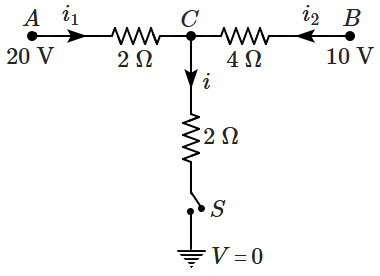In the electric network shown, when no current flows through the \(4~\Omega\) resistor in the arm \({EB},\) the potential difference between the point \({A}\) and \({D}\) will be:

1. \(6~\text{V}\)
2. \(3~\text{V}\)
3. \(5~\text{V}\)
4. \(4~\text{V}\)

1. \(6~\text{V}\)
2. \(3~\text{V}\)
3. \(5~\text{V}\)
4. \(4~\text{V}\)
Subtopic: Kirchoff's Current Law |
57%
Level 3: 35%-60%
JEE
Please attempt this question first.
Hints
Please attempt this question first.
In the circuit shown, when the switch \({S}\) is closed, what will be the value of the current \({i}\)?


| 1. | \(3~\text{A}\) | 2. | \(5~\text{A}\) |
| 3. | \(4~\text{A}\) | 4. | \(2~\text{A}\) |
Subtopic: Kirchoff's Current Law |
80%
Level 1: 80%+
Please attempt this question first.
Hints
Please attempt this question first.
A current of \(6\) A enters at the corner \(P\) of an equilateral triangle \(PQR,\) with each side having a wire of resistance \(2~\Omega.\) The current exits at corner \(R.\) The currents \(i_1 \) in ampere is:
1. \(2\)
2. \(3\)
3. \(6\)
4. \(9\)
Subtopic: Kirchoff's Current Law |
59%
Level 3: 35%-60%
JEE
Please attempt this question first.
Hints
Please attempt this question first.
In the given circuit, the current passes through \(20~\Omega\) is:

1. \(0.45~\text A\)
2. \(0.23~\text A\)
3. \(0.40~\text A\)
4. \(0.78~\text A\)

1. \(0.45~\text A\)
2. \(0.23~\text A\)
3. \(0.40~\text A\)
4. \(0.78~\text A\)
Subtopic: Kirchoff's Current Law |
68%
Level 2: 60%+
JEE
Please attempt this question first.
Hints
Please attempt this question first.



